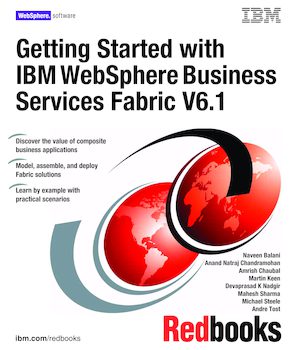Getting Started with IBM WebSphere Business Services Fabric V6.1
An IBM Redbooks publication
Note: This is publication is now archived. For reference only.

Published on 26 June 2008
ISBN-10: 0738485152
ISBN-13: 9780738485157
IBM Form #: SG24-7614-00
Authors: Martin Keen, Naveen Balani, Anand Natraj Chandramohan, Amrish Chaubal, Devaprasad K Nadgir, Mahesh Sharma, Michael Steele and Andre Tost
WebSphere® Business Services Fabric (Fabric) is a comprehensive service-oriented architecture (SOA) offering that is designed to extend the IBM® business process management platform to deliver flexible composite business applications.
In this IBM Redbooks® publication, we provide a complete overview of Fabric, from an architectural introduction, to an installation guide, and a step-by-step scenario that describes how to model, assemble, deploy, and manage composite business applications.
Part 1 of this book is an architectural and technical introduction to Fabric and related concepts.
In Part 2, we use a fictitious business scenario to show you how to build composite business applications in Fabric. We also provide extensive step-by-step instructions.
In Part 3, we discuss how to integrate Fabric with other IBM solutions and technologies, which includes WebSphere Service Registry and Repository, Tivoli® Composite Application Manager for SOA, and Lightweight Directory Access Protocol (LDAP).
Part 1. Introduction
Chapter 1. Welcome to this Redbooks publication
Chapter 2. Business Process Management enabled by SOA
Chapter 3. Introduction to WebSphere Business Services Fabric
Chapter 4. Technical overview of WebSphere Business Services Fabric
Part 2. Building Fabric solutions
Chapter 5. Business scenario for this book
Chapter 6. Installing and configuring Fabric
Chapter 7. Overview of developing a Fabric solution
Chapter 8. Modeling Fabric solutions
Chapter 9. Assembling Fabric solutions
Chapter 10. Deploying Fabric solutions
Chapter 11. Migrating Fabric projects across environments
Chapter 12. Adapting to changing business needs
Chapter 13. Best practices and troubleshooting
Chapter 14. Industry Content Packs
Part 3. Integration
Chapter 15. Integrating with WebSphere Service Registry and Repository
Chapter 16. Integrating with IBM Tivoli Composite Application Manager for SOA
Chapter 17. Integrating with Lightweight Directory Access Protocol
Appendix A. Additional material